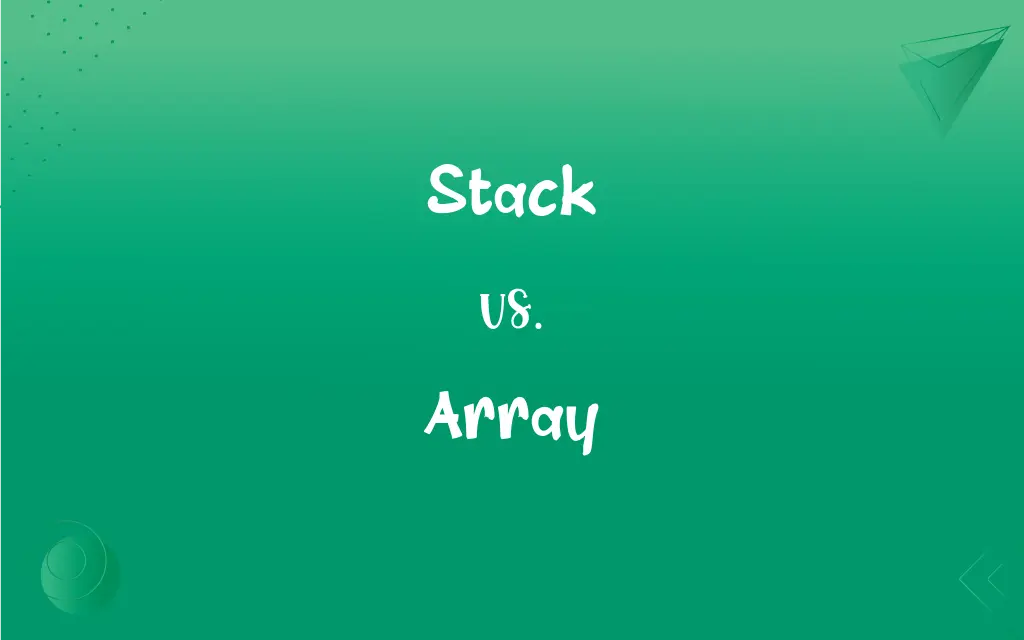Stack vs. Array: What's the Difference?
Edited by Harlon Moss || By Janet White || Published on February 10, 2024
A stack is a LIFO (Last In First Out) data structure, while an array is a collection of elements with indexed access.

Key Differences
A stack is a dynamic data structure that follows the Last In First Out (LIFO) principle, where the last element added is the first one to be removed. An array, on the other hand, is a static data structure consisting of a collection of elements, each identified by an array index. Both stack and array are fundamental in storing and managing data, but they differ in their data access and manipulation methods.
In terms of data access, a stack allows only the top element to be accessed or removed at any given time, ensuring a LIFO order. An array provides direct access to any element through its index, making it more flexible for random access compared to a stack. Both structures are commonly used in programming, but their choice depends on the specific requirements of data handling.
Regarding memory allocation, stacks can dynamically grow and shrink as elements are added or removed, making them more flexible in memory usage. Arrays, in contrast, have a fixed size determined at the time of declaration, which limits their capacity but ensures predictable memory allocation. Both stack and array have their own efficiency and limitations concerning memory usage.
In implementation, stacks are often built using arrays or linked lists, with operations like push and pop to add and remove elements. Arrays, being a fundamental data structure, can be directly implemented in most programming languages and are used as the basis for more complex structures, including stacks. Both structures are pivotal in various programming tasks, from simple data storage to complex algorithm implementations.
In practical applications, stacks are ideal for tasks that require reversing order or tracking history, such as undo mechanisms in software. Arrays are more suited for situations where fast access to elements at specific positions is necessary, like storing a list of items. Both stack and array play distinct yet crucial roles in computer science and programming.
ADVERTISEMENT
Comparison Chart
Order of Operation
LIFO (Last In First Out)
Indexed Access
Access Method
Top Element Only
Any Element via Index
Memory Allocation
Dynamic
Static
Primary Operations
Push and Pop
Insertion and Deletion
Typical Use Cases
Undo Mechanisms, Backtracking
Data storage, Lookups
ADVERTISEMENT
Stack and Array Definitions
Stack
A pile of items arranged one on top of another.
She placed the books in a neat stack on the table.
Array
An arrangement of numbers, shapes, or symbols in rows and columns.
The math problem involved calculating the sum of the values in the array.
Stack
A large, tall chimney or column of smoke or steam.
The factory's stack was visible from miles away.
Array
An orderly arrangement or display.
The museum featured an array of ancient artifacts.
Stack
A number of aircraft flying in circles at different altitudes waiting to land.
The control tower managed the stack of planes efficiently during the busy hours.
Array
Clothing, especially of a particular or formal type.
She dressed in an impressive array for the gala.
Stack
A set of shelves for storing hay, grain, or the like.
The farmer stored the freshly harvested corn in the barn stack.
Array
A large number or wide range of people or things.
The conference attracted an array of experts from various fields.
Stack
A linear data structure following the LIFO principle.
The programmer used a stack to reverse the string.
Array
A data structure consisting of a collection of elements, each identified by an array index.
The program used an array to store the temperature readings.
Stack
An orderly pile, especially one arranged in layers
A stack of newspapers.
Array
To set out for display or use; place in an orderly arrangement
Arrayed the whole regiment on the parade ground.
FAQs
What is an array?
An array is a collection of elements, each identified by an indexed position.
What is a real-world example of a stack?
A pile of plates in a cafeteria is a real-world example of a stack.
What are common uses of a stack?
Stacks are commonly used for undo mechanisms and backtracking algorithms.
What is a stack?
A stack is a data structure that follows the Last In First Out (LIFO) principle.
How do you access elements in a stack?
In a stack, you access only the top element.
What is the primary operation in a stack?
The primary operations in a stack are 'push' to add and 'pop' to remove elements.
Can stacks be implemented using arrays?
Yes, stacks can be implemented using arrays or linked lists.
Can a stack grow and shrink?
Yes, a stack can dynamically grow and shrink as elements are added or removed.
Is an array versatile in terms of accessing elements?
Yes, an array's direct indexing makes it versatile for accessing elements.
Are stacks suitable for tasks requiring reversing order?
Yes, stacks are ideal for tasks that require reversing the order of elements.
Can you access any element in an array?
Yes, you can access any element in an array using its index.
Are arrays fixed in size?
Yes, arrays typically have a fixed size defined at the time of creation.
What is the advantage of array's direct access?
The advantage of an array's direct access is quick retrieval and update of elements.
Can arrays store data of different types?
Typically, arrays store data of the same type, but some languages allow mixed types.
What operations are common in arrays?
Common operations in arrays include insertion and deletion of elements.
Are arrays used in complex data structures?
Yes, arrays are often used as the foundation for more complex data structures.
What makes an array different in memory usage?
An array's fixed size makes its memory usage predictable but limited.
Are stacks and arrays interchangeable?
No, stacks and arrays serve different purposes and are not interchangeable.
What is the stack's memory allocation like?
A stack's memory allocation is dynamic, adapting to the number of elements.
How does a stack operate in computer programming?
In programming, a stack operates by adding or removing elements from the top.
About Author
Written by
Janet WhiteJanet White has been an esteemed writer and blogger for Difference Wiki. Holding a Master's degree in Science and Medical Journalism from the prestigious Boston University, she has consistently demonstrated her expertise and passion for her field. When she's not immersed in her work, Janet relishes her time exercising, delving into a good book, and cherishing moments with friends and family.
Edited by
Harlon MossHarlon is a seasoned quality moderator and accomplished content writer for Difference Wiki. An alumnus of the prestigious University of California, he earned his degree in Computer Science. Leveraging his academic background, Harlon brings a meticulous and informed perspective to his work, ensuring content accuracy and excellence.




































































